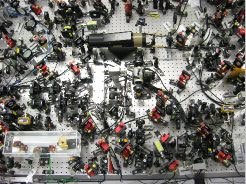Sep 9 2009
A new way of storing and 'echoing' pulses of light has been discovered by a team from The Australian National University, allowing bursts of laser to work as a flexible optical memory and potentially assist in extending the range of quantum information systems.
 The experiment that generated the photon echo effect.
The experiment that generated the photon echo effect.
Technologies like quantum cryptography are being developed to send secure information coded onto light beams from one point to another. Yet at present these systems are unable to extend beyond a distance of 50 to 100 kilometres because, beyond that range, too much of the information is lost.
But a team based at the ARC Centre of Excellence in Quantum-Atom Optics at ANU has demonstrated how photon echoes can be used to create a quantum memory device – meaning that pulses of light can be captured, stored and then released on demand. Such a device would be an important part of a quantum repeater, which could extend the range of secure quantum communication.
“Light can be a fantastic medium for transferring lots of information very quickly, but it doesn’t like to stay in one place for long,” explains team member Dr Ben Buchler. “This is the problem of optical memory – how to keep the information coded on light in one place so you can access it again later. One method is to slow the light down so it’s as good as frozen in place for a while. The way we’ve explored is to absorb the light in a cloud of atoms, which you can then manipulate to release the light at will.”
In experiments performed by PhD candidate Mahdi Hosseini, the ANU research team developed a method where pulses of laser light are absorbed into a cloud of atoms surrounded by a coil of wire. The coil creates a magnetic field that shifts the frequency of the atoms. After absorbing the laser pulses, the atoms all begin to spin at different speeds, depending on their frequency. If the magnetic field is reversed, the atoms all change direction and spin the other way. When the spinning atoms return to the state they were in when they absorbed the light, the laser pulses are released as a photon echo.
“But we take it a few steps further,” explains Dr Buchler. “We can also stretch, compress and split the pulses when we let them out. Best of all, we can recall the pulses in any order, just like a random access memory in a computer can recall electronic information in any order. To do this we use a second control laser beam that can turn the photon echo on and off. In a regular photon echo system, once the atoms all re-align the stored light just comes out – you can’t stop it. In our system, the combination of control beam and magnetic field switching makes it possible to choose exactly when to recall any one of the stored pulses, how much of it to recall and how fast to recall it.”
The research, published in Nature, outlines how the team have managed to store laser pulses with efficiencies above 40 per cent using its technique. The team includes Dr Ben Buchler, Ben Sparkes, Gabriel Hetet, Mahdi Hosseini, Dr Jevon Longdell (now at the University of Otago) and Professor Ping Koy Lam from ANU.